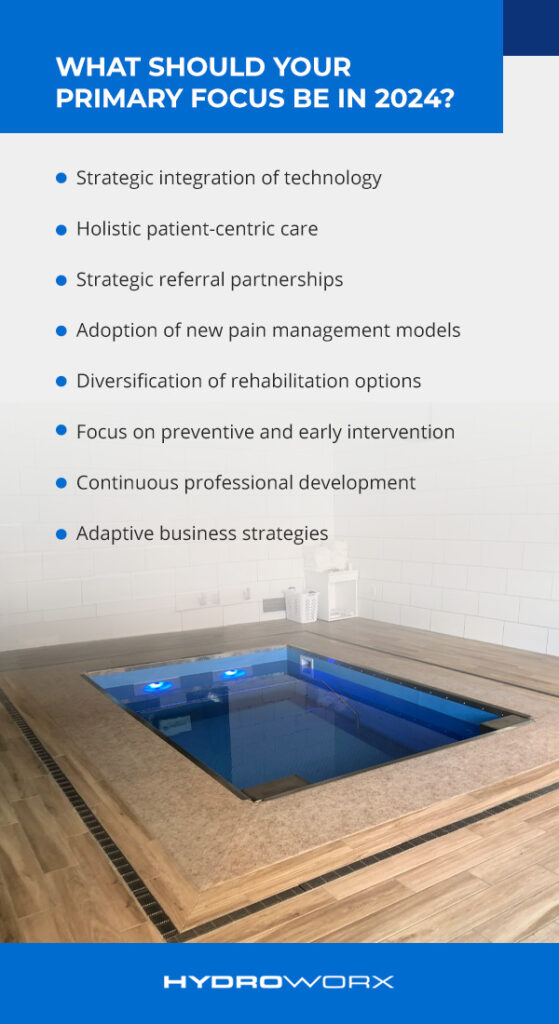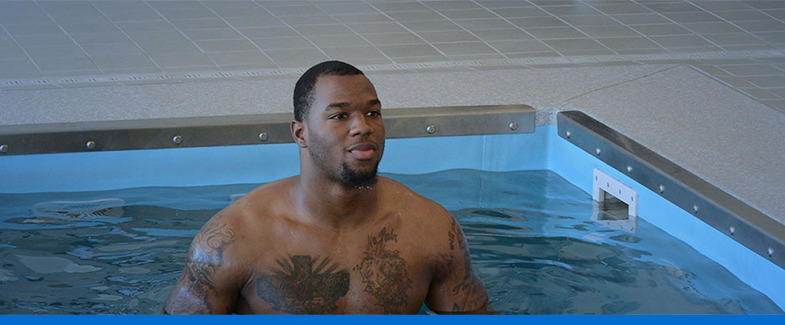Rising Trends for Physical Therapy in 2024
As we step into 2024, we will see a few exciting health care industry trends — more specifically, trends in physical therapy. These shifts present various opportunities to physical therapists in the space, alongside associated care professionals like primary care physicians.
The top trends include advancements in physical therapy technology and the continued adoption of aquatic therapy. Knowing the future of physical therapy may give you a competitive advantage that benefits your facility and your patients.
Current Trends in Physical Therapy
Understanding how the industry looks currently can help you get a clearer picture of what to expect moving forward.
Application Insights
Application-wise, orthopedic therapy has the largest share, exceeding 58.50% in 2022. This share is likely due to the increasing cases of musculoskeletal disorders and sports injuries. In comparison, geriatric therapy shows the most potential for growth, fueled by the rising population of older adults.
Settings Insights
Looking into the different settings, outpatient clinics led the market with a share of over 50.50% in 2022. This trend was supported by the cost savings and convenience these clinics offer. Simultaneously, the homecare settings segment witnessed notable growth. This setting’s growth is also owed to cost-effectiveness, practicality and the rising preference for telerehabilitation services.
Payer Insights
Private insurance dominated the industry, making up more than 57% of the share in 2022. The collaboration between private health insurance firms and health care facilities secures the private insurance segment’s position. Of course, public insurance and out-of-pocket payments also play a role, with initiatives by Medicare and Medicaid contributing to the sector’s growth.
Key Market Players
The market’s highly fragmented nature shows the continual efforts by large and smaller players to strengthen their foothold. Key players such as U.S. Physical Therapy, Inc., Select Physical Therapy and ATI Physical Therapy led the market. Their leadership in the market is due to their strategic expansion initiatives and partnerships.
Physical Therapy Profession
When looking at the profession itself, it is on an upward trajectory. According to the American Physical Therapy Association (APTA), the number of licensed physical therapists reached around 238,000 in 2023. In comparison, this number was about 232,000 in 2022.
How Is the Physical Therapy Space Expected to Grow in the Coming Years?
As of 2022, the U.S. physical therapy services market was valued at $44.8 billion. Researchers anticipate this market will experience a steady compound annual growth rate of 3.56% between 2023 and 2030.
This trajectory reflects the industry’s resilience, adaptability and role in addressing the shifting health care needs of the population. What will be the critical drivers for this future growth? Here are a few to consider:
- Aging population: An aging population will likely increase the demand for rehabilitation services. Older individuals often require physical therapy to maintain mobility and manage age-related conditions.
- Medical technology advancements: Additionally, advancements in medical technology and treatment techniques are expected to enhance the effectiveness of physical therapy. This technology will attract more patients who seek alternative and non-invasive solutions. Also, telehealth and remote monitoring capabilities are expected to expand access to physical therapy services, especially in rural or underserved areas.
- Interdisciplinary health care: Collaborative approaches, involving multidisciplinary health care teams, may become more prevalent to address holistic patient care. This trend can further boost the demand for physical therapy.
- Health-focused population: The ongoing focus on health and wellness in society will likely lead to an increased demand for preventive and rehabilitative services, positioning the physical therapy space for sustained growth.
8 Trends in Physical Therapy for 2024
As we enter 2024, the landscape of physical therapy is on the brink of transformative changes — all thanks to the technological innovations and evolving practices from previous years.
Beyond how technology has changed physical therapy, are there other health care trends that clinicians should consider? Let’s go over the top eight emerging trends that will define the trajectory of physical therapy in the coming year.
1. Preventing Physical Therapy Worker Burnout
With physical therapists facing high-volume workloads and other job stressors, the industry contends with high burnout rates.
Countering burnout requires a dual approach focused on individual and environmental factors. There are coping strategies and cognitive-behavioral techniques that can mitigate stress for clinicians. For example, some propose the solution of increasing training in psychologically informed care and initiatives.
Balancing individual well-being with systemic improvements can help build a resilient and healthy physical therapy workforce.

2. Closing the Gap in Depression Care
In 2024, physical therapists are taking center stage in mental health management — particularly in addressing depression. The growing need for physical therapists in mental health environments comes from the requirement for comprehensive, interdisciplinary strategies to tackle the intricate aspects of mental health conditions.
Physical therapists are well-suited to address symptoms related to depression, anxiety and traumatic stress. Leveraging the mind-body connection, these professionals can help manage symptoms through low-intensity psychological interventions.
3. Artificial Intelligence (AI)
AI’s popularity and applicability will continue growing in 2024 — and the physical therapy industry is no exception.
Physical therapists can use AI to help enhance patient care by analyzing vast amounts of patient data. This efficiency can help physical therapists create tailored rehabilitation programs considering individual needs and progress. Moreover, AI algorithms help forecast pain patterns and anticipated responses to treatments. Physical therapists can use these algorithms to optimize their patients’ pain management strategies.
Beyond AI, there is virtual reality and augmented reality. These applications will help enhance therapeutic interventions as they create new immersive and engaging exercises. AI-powered wearable devices can also provide patient insights that allow physical therapists to make real-time adjustments in treatment plans. These wearables can monitor patient movements, exercise adherence and pain levels.
AI can help physical therapists improve efficiency in their facilities and help personalize patient care, all with the help of advanced analytics and technology.
4. The New PRISM Pain Model
The APTA and the National Institutes of Health collaborated in 2023 to develop the Pain Recovery and Integrative Systems Model, or PRISM. Historically, there was no model of pain management to use in the physical therapy profession. However, these two institutions closed this gap, and there will be an increasing use of this model in 2024.
This innovative approach bypasses the traditional biopsychosocial model to help aid clinicians in decision-making and treatment. PRISM addresses the multidimensional nature of pain, facilitating pain recovery in line with contemporary approaches to pain management.
Already presented at numerous physical therapy conferences, PRISM can be seen as a testament to the industry’s commitment to advancing and refining its understanding of pain.
5. Primary Care
The shift toward preventive, holistic, patient-centered health care will help propel primary care physical therapy into the spotlight in 2024.
Prioritizing non-pharmacological interventions, physical therapists provide alternatives for managing pain and chronic conditions, which align with the overarching trend of early intervention aimed at minimizing health care expenditures. The expanded scope of this practice — allowing direct patient access — also helps facilitate quicker and more efficient care.
Further, collaborative care models enhance the interdisciplinary approach to patient well-being. They respond to patient preferences for comprehensive and satisfying multidisciplinary care.
This shift further emphasizes holistic, patient-centric and cost-effective approaches to improve patient health outcomes.
6. Aquatic Therapy
Also known as hydrotherapy, this therapeutic technique offers a low-impact environment for rehabilitation. Aquatic therapy is recognized for its therapeutic benefits, such as reduced joint stress and enhanced flexibility, making it an attractive option for diverse patient populations.
Clinicians incorporating aquatic therapy into their facilities will witness its efficacy in helping address musculoskeletal issues and promote patient well-being. As this trend continuously gains momentum, physical therapists should consider its potential to enhance patient outcomes and satisfaction.

7. New Technologies
The new era of patient care is here and uses different kinds of innovative technologies. One of the most notable examples is the integration of motion capture technology. Coupled with advancements in wearable sensors, this health care technology trend enhances the precision and personalization of care plans.
Virtual reality will also play an essential role in providing immersive experiences that aid in improving balance and gait issues. Additionally, video games are proving to be more than just entertainment. This media type can be an effective tool to promote patient engagement and adherence to therapy plans. When physical therapy becomes more enjoyable, patients are more likely to make their appointment time and continue on their care journeys.
Moreover, rehabilitation robotics, including exoskeletons and intelligent prosthetics, help patients recover. The advanced technologies offer tailored support that evolves with their progress. New technologies are also making their mark in facility management. Innovative software can help automate administrative tasks, which can increase efficiency and accuracy.
Also, the continued rise of telehealth is reshaping how patients access and experience physical therapy. This technology caters to patients seeking more flexible and convenient ways of rehabilitation.
8. Increased Need for Physical Therapy Referrals
As physical therapists expand their role in managing mental health and providing holistic care, their collaboration with physicians becomes more crucial. Physicians continue to recognize the potential of physical therapy interventions, and they will be vital in referring patients for timely and effective rehabilitation.
Clinicians and facility directors should actively cultivate strong relationships with referring physicians. They can do this by highlighting the benefits of collaborative care models to enhance patient well-being.
What Should Your Primary Focus Be in 2024?
What should you do to propel your facility forward in 2024? Here’s how you can make the most of these trends and opportunities:
- Strategic integration of technology: Incorporate new technologies into your facility. From wearable devices monitoring patient movements to AI-driven rehabilitation programs, clinicians can implement an array of gear into their facilities to support patients and remain technologically savvy. Invest in training for your team to harness the full potential of these advancements and enhance efficiency, personalization of care and patient outcomes.
- Holistic patient-centric care: Shift toward a holistic and patient-centered approach to health care, aligning your services with the broader comprehensive and patient-centric care trend. You can explore opportunities to collaborate with mental health professionals to embrace this trend.
- Strategic referral partnerships: Cultivate strong relationships with referring physicians. The increased need for referrals in 2024 emphasizes the importance of collaboration between physical therapists and physicians. Clearly communicate the benefits of collaborative care models. You can highlight the positive impact on patient outcomes and health care efficiency.

- Adoption of new pain management models: Familiarize yourself with innovative pain management models like PRISM to stay abreast of evolving facilities. Implement these models to enhance your decision-making processes and treatment plans.
- Diversification of rehabilitation options: Recognize the growing demand for diverse rehabilitation options. Consider incorporating aquatic therapy into your facility and leverage its therapeutic benefits for various patient populations. Facility directors, in particular, should assess the feasibility of investing in aquatic therapy resources to meet this demand and provide a well-rounded suite of services.
- Focus on preventive and early intervention: Emphasize preventive and early intervention strategies to align your facility with the shift toward proactive health care. As primary care physical therapy expands, capitalize on non-pharmacological interventions to address pain management and chronic conditions. Position your services as beneficial solutions that contribute to reducing health care costs through early detection and intervention.
- Continuous professional development: Commit to ongoing professional development. Stay informed about the latest research, trends and best practices in the field. Encourage your team to participate in educational sessions to help position your facility as a leader in the industry. As a result, you can continue providing your patients with advanced, modern care.
- Adaptive business strategies: Adopt adaptive business strategies that accommodate the evolving health care landscape. Anticipate changes in patient preferences, reimbursement models and regulatory environments. Stay agile and ready to pivot your business strategies to meet new demands as they arise.
Get Ahead of the Curve With HydroWorx’s Cutting-Edge Solutions
As you start your new year, consider getting ahead of the competition with one of these trends — hydrotherapy. This physical therapy care technique can provide numerous benefits for a range of patients, allowing you to meet more patient needs. Additionally, incorporating new techniques into your facility can keep you ahead of the curve, so you remain competitive in the industry.
It’s clear that hydrotherapy is only becoming more popular across physical therapy facilities. HydroWorx offers superior therapy and fitness pool solutions that offer users the immense benefits of aquatic therapy. Our products redefine patient care and outcomes standards, so you can trust in our pool solutions and vast experience in the industry to help you lean into this quickly growing trend.
Ready to take the next step and incorporate aquatic wellness pools into your physical therapy facility? Browse our products or contact us today for more information.



